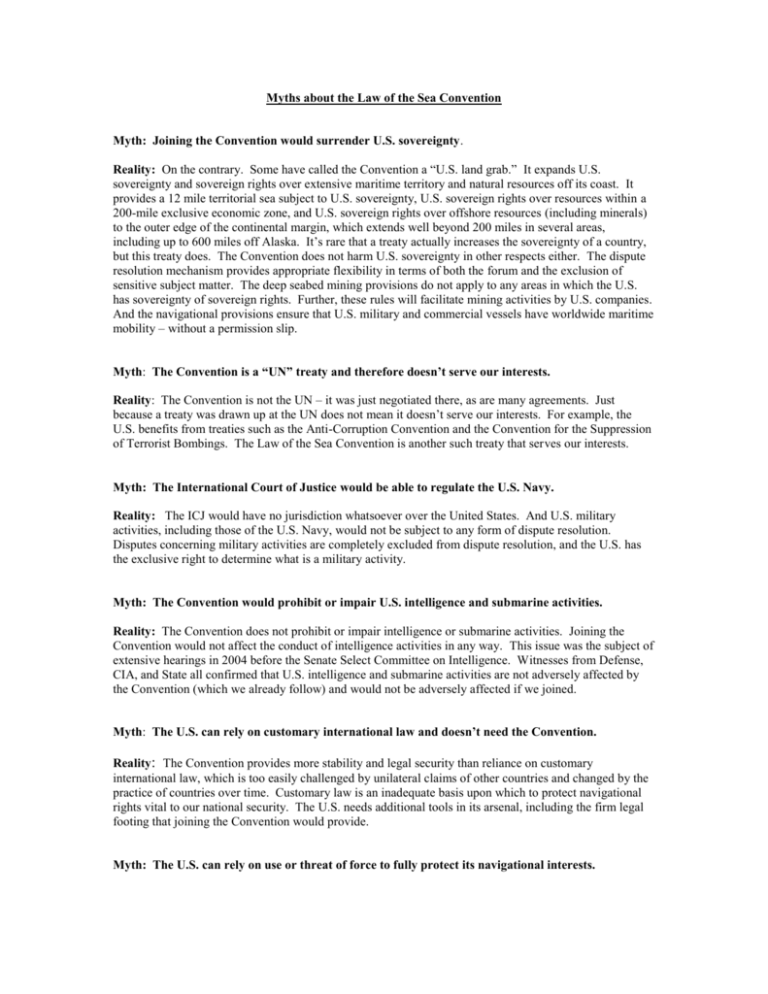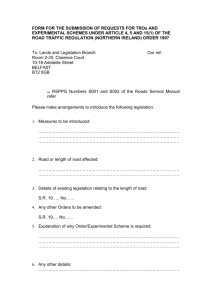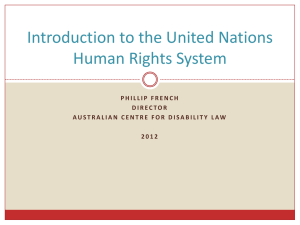Myths - NSL PACSW Events
advertisement

Myths about the Law of the Sea Convention Myth: Joining the Convention would surrender U.S. sovereignty. Reality: On the contrary. Some have called the Convention a “U.S. land grab.” It expands U.S. sovereignty and sovereign rights over extensive maritime territory and natural resources off its coast. It provides a 12 mile territorial sea subject to U.S. sovereignty, U.S. sovereign rights over resources within a 200-mile exclusive economic zone, and U.S. sovereign rights over offshore resources (including minerals) to the outer edge of the continental margin, which extends well beyond 200 miles in several areas, including up to 600 miles off Alaska. It’s rare that a treaty actually increases the sovereignty of a country, but this treaty does. The Convention does not harm U.S. sovereignty in other respects either. The dispute resolution mechanism provides appropriate flexibility in terms of both the forum and the exclusion of sensitive subject matter. The deep seabed mining provisions do not apply to any areas in which the U.S. has sovereignty of sovereign rights. Further, these rules will facilitate mining activities by U.S. companies. And the navigational provisions ensure that U.S. military and commercial vessels have worldwide maritime mobility – without a permission slip. Myth: The Convention is a “UN” treaty and therefore doesn’t serve our interests. Reality: The Convention is not the UN – it was just negotiated there, as are many agreements. Just because a treaty was drawn up at the UN does not mean it doesn’t serve our interests. For example, the U.S. benefits from treaties such as the Anti-Corruption Convention and the Convention for the Suppression of Terrorist Bombings. The Law of the Sea Convention is another such treaty that serves our interests. Myth: The International Court of Justice would be able to regulate the U.S. Navy. Reality: The ICJ would have no jurisdiction whatsoever over the United States. And U.S. military activities, including those of the U.S. Navy, would not be subject to any form of dispute resolution. Disputes concerning military activities are completely excluded from dispute resolution, and the U.S. has the exclusive right to determine what is a military activity. Myth: The Convention would prohibit or impair U.S. intelligence and submarine activities. Reality: The Convention does not prohibit or impair intelligence or submarine activities. Joining the Convention would not affect the conduct of intelligence activities in any way. This issue was the subject of extensive hearings in 2004 before the Senate Select Committee on Intelligence. Witnesses from Defense, CIA, and State all confirmed that U.S. intelligence and submarine activities are not adversely affected by the Convention (which we already follow) and would not be adversely affected if we joined. Myth: The U.S. can rely on customary international law and doesn’t need the Convention. Reality: The Convention provides more stability and legal security than reliance on customary international law, which is too easily challenged by unilateral claims of other countries and changed by the practice of countries over time. Customary law is an inadequate basis upon which to protect navigational rights vital to our national security. The U.S. needs additional tools in its arsenal, including the firm legal footing that joining the Convention would provide. Myth: The U.S. can rely on use or threat of force to fully protect its navigational interests. Reality: The United States has utilized diplomatic and operational challenges to resist the excessive maritime claims of other countries that interfere with U.S. navigational rights. But these operations entail a certain degree amount of risk, as well as resources. Being a party to the Convention would significantly enhance our efforts to roll back these claims by, among other things, putting the U.S. in a strong position to assert our rights. Myth: Joining the Convention would hurt U.S. maritime interdiction efforts under the Proliferation Security Initiative (PSI). Reality: Joining the Convention would not affect applicable maritime law or policy regarding the interdiction of weapons of mass destruction. PSI specifically requires participating countries to act consistent with international law, which includes the law reflected in the Convention. Almost all PSI partners are parties to the Convention. Further, joining the Convention is likely to strengthen PSI by attracting new cooperative partners. Myth: The Convention was drafted before – and without regard to – the war on terror and what the U.S. must do to wage it successfully. Reality: The Convention enhances, rather than undermines, our ability to wage the war on terror. Maximum maritime naval and air mobility that is assured by the Convention is essential for our military forces to operate effectively. The Convention provides the necessary stability and framework for our forces, weapons, and materiel to get to the fight without hindrance. It is essential that key sea and airlines remain open as an international legal right and not be contingent upon approval from nations along the routes. Myth: The Convention gives the UN its first opportunity to levy taxes. Reality: [ ] Myth: President Reagan thought the treaty was irremediably defective. Reality: President Reagan pointed solely to certain deep seabed mining provisions of the Convention as flawed. He considered that those provisions could be fixed and specifically identified the elements in need of revision. In a 1983 Ocean Policy Statement, President Reagan directed the U.S. government to abide by the non-deep-seabed provisions of the Convention and encourage other countries to do likewise. The 1994 Agreement fixed the flawed deep seabed mining provisions in ways that meet each one of President Reagan’s objections. Myth: The Convention provides for mandatory technology transfer. Reality: No technology transfers are required by the Convention. Mandatory technology transfer was eliminated by the 1994 Agreement that fixed the original Convention.








